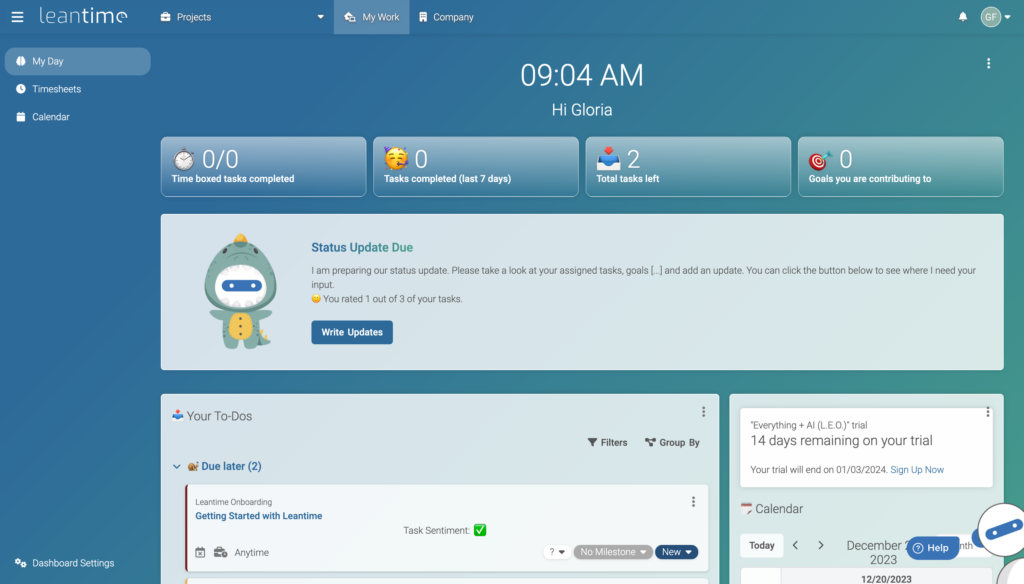Estimated reading time: 12 minutes
An inclusive workplace culture is essential for a successful, productive, and engaged workforce, whether you’re an early-stage startup, a well-established organization, or even a large enterprise company. Inclusion creates an environment that fosters psychological safety, boosts morale, has learning and development opportunities and welcomes diverse employees as part of its organizational culture.
By embracing an inclusive culture and ensuring employees are treated fairly, organizations can create a supportive atmosphere that promotes growth and success. Inclusivity enhances employee experience and job satisfaction and drives innovation by harnessing the power of diverse perspectives and experiences.
Table of contents
- What Is Inclusion?
- Why Is Inclusion Important?
- Inclusion Alone Does Not Promote Diversity
- Creating a Diverse and Inclusive Workplace Culture
- The Role of Leadership and Management in Creating an Inclusive Culture
- Create an Environment of Open Communication
- Providing Mental Health Support & Employee Resource Groups
- Flexibility and Accommodations Are Essential
- Recognition and Appreciation: Essential Components of a Supportive Work Environment
- Team-Building Activities: Cultivating Supportive Work Inclusion Efforts
- Conclusion
What Is Inclusion?
Inclusion is more than just a checkbox; it’s a commitment to creating an environment where every team member feels valued, respected, and heard. It goes beyond acknowledging differences—it celebrates them. Inclusion is about fostering a culture that actively seeks and welcomes diverse perspectives, experiences, and backgrounds.
It’s not merely about inviting everyone to the table; it’s ensuring that each voice has an equal opportunity to contribute and shape the narrative.
Why Is Inclusion Important?
Inclusion transcends mere idealism, emerging as a strategic imperative substantiated by compelling data. Many studies consistently underscore that diverse talent and inclusive environments yield superior outcomes and heightened organizational performance.
According to McKinsey & Company, companies in the top quartile for gender diversity on executive teams are 25% more likely to experience above-average profitability than those in the bottom quartile. [1] Similarly, ethnically diverse executive teams exhibit a 36% higher likelihood of outperforming their peers financially. [2]
In the broader organizational context, the advantages of inclusion become even more pronounced. Diverse teams bring a spectrum of perspectives, skills, and problem-solving approaches, enhancing adaptability and resilience in the face of challenges.
Moreover, inclusion directly impacts employee engagement and retention. A Deloitte report establishes that organizations with inclusive cultures are eight times more likely to achieve better business outcomes, while inclusive leaders are six times more likely to be effective in their roles. Beyond the bottom line, fostering an inclusive environment contributes to a positive workplace culture, fostering creativity, collaboration, and a profound sense of belonging.
In an era where innovation reigns supreme and the global marketplace demands agility, the data unambiguously supports the business case for inclusion. The statistics underscore the imperative to prioritize inclusion, not only as an ethical commitment but as a strategic advantage for organizations seeking enduring success.
Inclusion Alone Does Not Promote Diversity
Inclusion and diversity are interconnected concepts, but they are not synonymous. Inclusion refers to creating an environment where every individual feels valued, respected, and included, irrespective of their differences. It’s about fostering a culture that actively seeks and welcomes diverse perspectives and ensures that everyone has an equal opportunity to contribute.
Diversity, on the other hand, involves recognizing, appreciating, and leveraging the differences among individuals, and affinity groups, whether they be related to race, gender, ethnicity, age, background, skills, or perspectives. Diversity encompasses the variety of characteristics and experiences that make each person unique.
While inclusion can exist without a visibly diverse group of individuals, it may not be as robust or effective. In an inclusive environment with limited diversity, efforts should be made to broaden the range of perspectives and experiences to enrich the overall collaborative and innovative potential.
However, it’s important to note that the ideal scenario is simultaneously promoting diversity and inclusion. True inclusion is most powerful when it embraces a diverse range of voices and backgrounds. By fostering an inclusive culture alongside diversity, organizations can harness the full spectrum of talents and perspectives, leading to increased innovation, creativity, and overall success.
Creating a Diverse and Inclusive Workplace Culture

Embracing diversity is fundamental to fostering a supportive work environment. The positive impact of diverse perspectives on innovation cannot be overstated. A team that draws from a wide range of experiences and backgrounds is more likely to have new ideas and generate creative solutions to complex problems, which in turn leads to a stronger, more dynamic organization.
It is important to recognize the value of diversity and ensure everyone has an equal chance to contribute. This can be achieved by promoting equal opportunities and addressing unconscious biases in the workplace. By creating an inclusive atmosphere where all team members feel valued and respected, organizations can unlock the full potential of their diverse workforce.
Recognizing the Value of Diversity
Acknowledging the importance of diversity is the first step toward building a more inclusive work environment. By appreciating the unique strengths and perspectives that each individual brings to the table, organizations can foster a sense of belonging and empower team members to thrive.
Moreover, an even more inclusive culture and workplace allows employees to feel comfortable sharing their ideas and insights, leading to increased collaboration and innovation. This ultimately results in a more dynamic and successful organization.
Understanding the Types of Diverse Groups
Diversity encompasses a myriad of dimensions, each contributing to the rich tapestry of human experience.
Cultural diversity spans ethnicity, nationality, sexual orientation, language, and traditions, celebrating the unique customs that shape individuals. Gender diversity recognizes the distinctions between male, female, and non-binary identities, fostering inclusivity for everyone.
Diversity also extends to age, acknowledging the wealth of perspectives that come with different life stages. Neurodiversity encompasses variations in neurological functions, ensuring that individuals with diverse cognitive styles are valued.
Additionally, diversity includes variations in abilities, embracing individuals with different physical and cognitive capacities. Socioeconomic diversity acknowledges differences in economic and social status, recognizing the impact these factors have on perspectives and opportunities.
Promoting Equal Opportunities
In order to embrace diversity, organizations must ensure that all team members have equal opportunities to contribute and grow within the company culture. This involves addressing unconscious biases and implementing strategies to promote fairness and inclusivity.
Some effective strategies include using inclusive behaviors, offering training programs to raise awareness about unconscious biases, setting clear expectations for behavior, and establishing transparent processes for decision-making. By creating a level playing field for everyone, organizations can foster a truly supportive work environment that values diversity and inclusion.
The Role of Leadership and Management in Creating an Inclusive Culture
In today’s rapidly evolving workplace landscape, the role of managers and leaders has transcended beyond traditional responsibilities. As organizations strive for innovation and growth, it becomes imperative for leadership to embrace diversity and neuroinclusion as fundamental pillars of success.
Did you know: 77 per cent of HR professionals and 71 per cent of senior leaders have not had specific neurodiversity training in the past 12 months [3]
Breaking Down Barriers
Educating managers on diversity involves dismantling stereotypes and biases that may unconsciously influence decision-making. By fostering a culture of inclusivity, leaders can empower their teams to embrace differences and capitalize on the strengths that each individual brings. This enhances creativity and contributes to a positive work environment, ultimately boosting employee morale and retention.
Addressing unconscious bias through Diversity Training Programs
A comprehensive diversity training program for management covers various key aspects, starting with an introduction to diversity and inclusion and a discussion on the business case.
It includes sessions on recognizing and mitigating unconscious biases, developing inclusive leadership skills, understanding legal and ethical considerations, and fostering cultural competence.
Specialized modules address LGBTQ+ inclusion, accessibility, and the impact of microaggressions. A well rounded professional development diversity program emphasizes practical application through case studies and encourages managers to create personalized action plans. Ongoing support and a commitment to diversity and inclusion are essential for sustained impact.
Driving Innovation
Inclusive leadership is a catalyst for innovation. When managers actively seek out and value diverse perspectives, they open the door to innovative solutions to complex problems. A neuroinclusive approach ensures that individuals with different thinking styles, including those with neurodivergent traits, are recognized for their unique contributions. This not only fosters a culture of continuous improvement but also positions the organization as a leader in innovation within its industry.
Enhancing Employee Engagement
Employees are more likely to be engaged and committed to their work when they feel seen, heard, and valued. By educating managers on the importance of diversity and neuro-inclusion, organizations can create a workplace where every individual feels a sense of belonging. This, in turn, leads to increased productivity, collaboration, and overall job satisfaction. Even more, inclusive workplaces can improve employee retention that’s 5.4x higher than less inclusive teams. [4]
Create an Environment of Open Communication
Open communication is essential for creating a supportive work environment. It fosters trust and collaboration, while allowing employees and team members to feel comfortable sharing their ideas and concerns. By building a culture of openness, organizations can promote a sense of unity and understanding within their teams.
Transparent communication plays a crucial role in fostering trust among team members. It involves sharing information openly, addressing issues as they arise, and ensuring everyone is on the same page. Organizations can create platforms for open dialogue within the team, such as regular check-ins, team meetings, and online channels dedicated to discussions and feedback. These avenues for communication encourage a culture of openness and support, enabling team members to express their thoughts and ideas freely.
Active listening is another vital aspect of open communication. To truly foster a supportive work environment, it is essential for team members to not only hear but also understand one another. This involves listening attentively, asking questions for clarification, and validating each other’s ideas and concerns. By promoting active listening among colleagues, organizations can create a sense of empathy and understanding within their teams, ultimately leading to a more inclusive and supportive work environment.
By embracing open communication and actively listening to one another, organizations can foster a sense of unity and understanding within their teams. This, in turn, leads to a more supportive work environment where everyone feels valued and empowered to contribute to the organization’s success.
Providing Mental Health Support & Employee Resource Groups
One crucial aspect of creating a supportive work environment is acknowledging and addressing mental health in the workplace. By destigmatizing mental health discussions and fostering a supportive atmosphere, organizations can positively impact employees’ mental well-being and overall job satisfaction.
Mental health is a vital component of a holistic approach to inclusivity. By recognizing its importance, organizations can help ensure that employees feel comfortable discussing their mental health needs and seeking assistance when required. The impact of a supportive work environment on mental well-being cannot be overstated; it helps reduce stress, boosts morale, and enhances overall job satisfaction.
Organizations can support their employees’ mental health by implementing resources and programs tailored to their needs. This may include mental health workshops, employee assistance programs, and access to mental health professionals. Promoting a healthy work-life balance is essential in maintaining mental well-being and preventing burnout.
Organizations can create a more inclusive and supportive work environment that benefits everyone by providing mental health support and fostering an environment that values open communication and understanding.
Flexibility and Accommodations Are Essential
Creating a supportive work environment goes hand in hand with offering flexibility and accommodations to cater to different groups’ working styles and needs. By tailoring work arrangements and ensuring accessibility for all employees, organizations can foster an inclusive atmosphere that promotes collaboration and productivity.
Flexible work hours and remote options provide numerous benefits for both employees and organizations. These arrangements enable team members to strike a better work-life balance, ultimately leading to increased job satisfaction and reduced stress levels.
Moreover, accommodating different working styles and needs allows organizations to tap into the full potential of their diverse workforce, ensuring that everyone has an equal opportunity to contribute to the team’s success.
Accessibility initiatives are essential to making the workplace inclusive for individuals with disabilities. Ensuring physical and digital accessibility for all employees not only complies with legal requirements but also demonstrates a commitment to inclusivity and equal opportunities.
By implementing accessibility measures, organizations create a supportive work environment where everyone can thrive and contribute to the best of their abilities.
Tools built for accessibility are another important piece to inclusive organizations. For example, Leantime is a work management system that can help you create a supportive work environment for your team.
Focusing on ADHD, Autism, and Dyslexia, Leantime has built features designed to make project management accessible to diverse backgrounds and skill sets. Learn more about Leantime’s inclusive project management features.

Recognition and Appreciation: Essential Components of a Supportive Work Environment
Recognizing and appreciating employees’ accomplishments is vital to fostering a supportive work environment. By celebrating achievements, encouraging employees and providing constructive feedback, organizations can create a culture of appreciation that boosts morale and promotes growth. This approach enhances job satisfaction and encourages a growth mindset within the team.
Celebrating individual and team accomplishments has a profound impact on the work environment. By acknowledging employees’ hard work and dedication, organizations demonstrate that they value their team members’ contributions.
This recognition fosters a sense of belonging and encourages employees to continue striving for success. Creating a culture of appreciation involves regularly acknowledging and celebrating achievements, both big and small, and ensuring that everyone feels seen and valued.
Team-Building Activities: Cultivating Supportive Work Inclusion Efforts
Team-building activities play a crucial role in fostering a supportive work environment. They help create a sense of community and unity among team members, leading to stronger collaboration and improved productivity. Organizations can build connections beyond the workplace and promote a truly inclusive atmosphere by ensuring that team-building activities cater to diverse interests and abilities.
Creating a Sense of Community
Team cohesion is essential for a supportive work environment. Fun and inclusive team-building activities help nurture this cohesion by encouraging collaboration and fostering a sense of camaraderie among team members.
By engaging in these activities, employees can learn more about their colleagues, develop stronger relationships, and appreciate the diverse skills and perspectives within the team. The resulting sense of community not only improves teamwork but also contributes to overall job satisfaction.
Diverse Team-Building
Organizations must ensure that team-building activities cater to diverse interests and abilities. By designing activities that accommodate various preferences and skillsets, organizations demonstrate their commitment to inclusivity and equal opportunities for all team members. Building connections beyond the workplace allows employees to develop deeper relationships and fosters a supportive work environment that values and respects individual differences.
Conclusion
It is crucial to remember that a supportive workplace not only leads to increased productivity and job satisfaction but also promotes a sense of belonging among existing employees and team members. As we have seen, the positive impact of inclusivity in the workplace is substantial, paving the way for a more dynamic and successful organization. We encourage you to adopt these strategies and witness the transformative power of a truly inclusive and supportive work environment.
Resources
[1] Dixon-Fyle, S., Dolan, K., Hunt, V., & Prince, S. (2020, May 19). Diversity wins: How inclusion matters. McKinsey & Company. View Resource
[2] McKinsey & Company. (2020). Diversity wins How inclusion matters. View Resource
[3] March 2023, Y. C. 10. (2023, March 10). Three quarters of HR professionals have not had specific neurodiversity training in the past 12 months, survey finds. View Resource
[4] Bush, M. (2023, August 25). Why Is Diversity & Inclusion in the Workplace Important? Great Place to Work. View Resource






